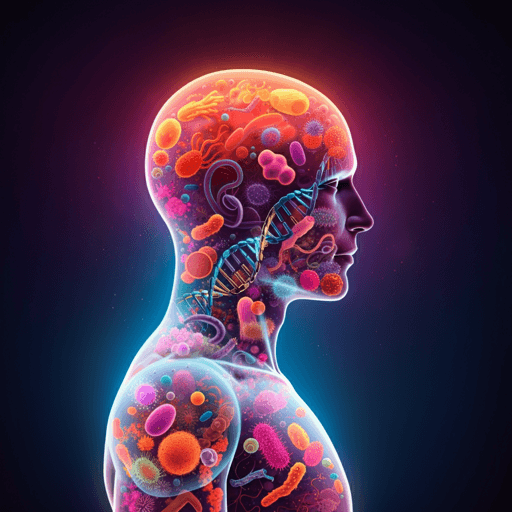
Medicine and Health
A systematic framework for understanding the microbiome in human health and disease: from basic principles to clinical translation
Z. Ma, T. Zuo, et al.
An integrative narrative review that reconceives the human microbiome as part of a 'meta-host', introducing concepts like the 'innate and adaptive genomes', 'germ-free syndrome', 'slave tissue', and 'acquired microbial immunity', and proposing the 'homeostatic reprogramming hypothesis' and 'cell-microbe co-ecology model' to explain post-industrial shifts in health. This research was conducted by Ziqi Ma, Tao Zuo, Norbert Frey, and Ashraf Yusuf Rangrez.
~3 min • Beginner • English
Introduction
This review addresses how to unify fragmented concepts and findings about the human microbiome into a coherent framework explaining its roles in health and disease. Motivated by the completion of the human genome, the emergence of a human pangenome, and large microbiome initiatives (HMP/iHMP, MetaHIT, AGP, DMP), the authors note that individual human genetic variation explains only a small fraction of phenotypic diversity. They argue that continuous crosstalk between the human genome and microbiomes contributes substantially to physiology and disease heterogeneity. Prior notions (holobiont, hologenome, super-organism, hygiene/old friends/microflora hypotheses) advanced the field but remained fragmented. The purpose here is to synthesize across anatomy, physiology, immunology, histology, genetics, and evolution to propose an integrated set of concepts (innate vs adaptive genomes, germ-free syndrome, slave tissue, acquired microbial immunity, homeostatic reprogramming, cell–microbe co-ecology, meta-host, and health–illness conversion) that together explain microbial distribution, development, regulation, and clinical implications.
Literature Review
The review summarizes extensive literature on: (1) human microbial biogeography and dynamics across life stages (gut, oral, skin, vaginal, respiratory sites), including recent advances in in vivo intestinal sampling capsules and rapid postmortem mapping; (2) challenges to sterility at traditionally sterile sites (vasculature, ocular surface, brain—still controversial) and the sterile womb vs in utero colonization debate; (3) microbial functions in digestion and metabolism (SCFAs, secondary bile acids, vitamins, nitrate–nitrite–NO pathway), immunomodulation and colonization resistance; (4) epigenetic regulation by microbiota (DNA methylation, histone modification, ncRNAs); (5) developmental and maternal/paternal transmission effects, and early-life windows shaping immunity; (6) germ-free animal phenotypes across organ systems; (7) evolutionary concepts (holobiont/hologenome) and host–microbe co-speciation; (8) host regulation of microbes (immune, neural, hormonal, nutritional niches, extracellular vesicles) and adaptation to diet, drugs, and environment; (9) community ecology (interactions, biofilms, phage dynamics, keystone taxa) and clinical phenomena (FMT, probiotics, prebiotics, synbiotics, postbiotics). It contrasts and critiques existing theories, motivating a unified framework for clinical translation.
Methodology
This is a narrative (non-systematic) review that integrates findings from diverse disciplines and large-scale microbiome projects (HMP/iHMP, MetaHIT, AGP, DMP) and recent primary studies across organ systems, development, immunity, metabolism, and evolution. The authors synthesize mechanistic, epidemiologic, omics (multi-omics, metagenomics, metabolomics), and gnotobiotic animal evidence to propose conceptual models (innate vs adaptive genomes, germ-free syndrome, slave tissue, acquired microbial immunity, homeostatic reprogramming, cell–microbe co-ecology, meta-host, health–illness conversion). No formal systematic search, meta-analysis, or risk-of-bias framework is reported; instead, representative and recent studies are curated to build a comprehensive conceptual synthesis aimed at clinical translation.
Key Findings
- Human microbial distribution and dynamics: Densest sites include gastrointestinal tract (~29%), oral cavity (~26%), skin (~21%), with lower densities in respiratory (~14%) and urogenital (~9%) tracts. Microbial communities follow life-stage successions (birth to old age), with relative stability and individual specificity; fecal and oral microbiomes are more stable over time than skin and nasal.
- Emerging evidence at traditionally sterile sites is mixed: stringent analyses find no common blood microbiome in healthy individuals; vascular, ocular, and brain microbiota remain under investigation with contamination concerns.
- Functions of commensals: Digestive and metabolic contributions (SCFAs—acetate, propionate, butyrate; secondary bile acids; vitamin K and B vitamins; nitrate–nitrite–NO pathway); immune education and tolerance; colonization resistance via bacteriocins, metabolites (SCFAs, secondary bile acids), contact-dependent systems, and niche modification (e.g., Lactobacilli acidification of vagina). Microbiota regulate epigenetics (DNA methylation, histone modifications, ncRNAs), immunity (e.g., Treg induction by butyrate), and neural pathways.
- Acquired microbial immunity: The microbiome provides adjunct defensive and regulatory capacity alongside innate and adaptive immunity, shaping barrier integrity, immune training, and pathogen resistance; it can be modulated naturally (breastfeeding HMOs) and therapeutically (FMT, probiotics, prebiotics, synbiotics, postbiotics).
- Germ-free syndrome (from GF animal models): Systemic abnormalities without microbiota include reduced growth (GF mice ~14.5% lower weight, ~4% shorter), cardiopulmonary changes (cardiac output ~30% lower in GF rats), altered intestinal morphology and motility (enlarged cecum, slower crypt renewal), immune defects (reduced GALT, sIgA, antimicrobial peptides; higher infection susceptibility), neurobehavioral alterations (increased BBB permeability; dendritic remodeling; anxiety-like behaviors; impaired social behavior reversible by certain commensals), reproductive irregularities (estrous cycle, BTB integrity), skeletal (increased bone mass due to reduced osteoclastogenesis), muscle (atrophy, mitochondrial dysfunction, NMJ impairment), adipose (browning, altered lipid metabolism), skin (barrier defects), metabolic circadian and hormonal changes (altered liver rhythms, lower ghrelin), and longevity patterns.
- Innate vs adaptive genome: The human (innate) genome is inherited, whereas the microbiome (adaptive genome) is acquired, dynamic, and host- and environment-responsive; together, they shape phenotypes and disease risk.
- Slave tissue hypothesis: Microbial communities function as dynamic, host-regulated tissue-like components integrated with epithelial, connective, muscular, and nervous tissues. Loss of control (dysbiosis) links to cardiometabolic, respiratory, digestive, neurological, endocrine, autoimmune, urogenital, dermatologic diseases, and cancers.
- Homeostatic reprogramming: Commensals act as an additional regulatory force alongside neural, immune, and metabolic systems, shifting the set-points/outputs of homeostatic indicators (e.g., body temperature, glucose, uric acid, blood pressure). Examples: microbiota modulate thermogenesis (BAT/WAT browning) and basal temperature; gut microbes consume uric acid compensating for uricase loss; microbiota influence glycemia via microbiota-modulated CART+ iEAN circuits; microbiome associates with blood pressure variation.
- Cell–microbe co-ecology model: Describes bidirectional influences between microbial community composition/products and cellular homeostasis of the host’s internal environment (plasma, tissue fluid, lymph), explaining how dysbiosis perturbs cellular equilibria.
- Meta-host concept: The host plus its symbiotic microbes determine colonization susceptibility, pathogen pathogenicity, and disease severity. Microbiota composition affects infection outcomes (e.g., EBV/HIV models, cervicovaginal communities and HIV risk) and transplant outcomes; SARS-CoV-2 infection associates with dysbiosis across multiple sites linked to inflammation and severity.
- Health–illness conversion model: Outlines four dysregulation patterns: (a) overgrowth at sites (e.g., SIBO), (b) translocation of microbes/components (e.g., LPS) causing systemic effects, (c) pathogenic shifts via microbial genetic adaptation within hosts, (d) increased harmful and reduced beneficial microbial products (e.g., TMA/TMAO, BCAAs, imidazole propionate; reduced SCFAs, vitamins).
- Modulators of the adaptive genome: Host regulation (immunity, neural, hormones, nutrients, ncRNAs), diet (fiber-specific bacterial shifts; diet patterns like Mediterranean, ketogenic, DASH), drugs (antibiotics and many non-antibiotics reshape microbiota and drug metabolism), environment (geography, greenspace, spaceflight), and established community interactions (cooperation, competition, phage dynamics, keystone taxa).
- Clinical translation: Microbiome manipulation (FMT, live biotherapeutics, probiotics/prebiotics/synbiotics/postbiotics), precision drug–microbiome interactions, and microbiome engineering (engineered probiotics, phage-CRISPR) show promise; donor screening and standardized guidelines remain critical.
Discussion
By reframing the microbiome as an adaptive genome and proposing complementary models (germ-free syndrome, slave tissue, homeostatic reprogramming, cell–microbe co-ecology, meta-host), the review unifies disparate findings on distribution, development, immunity, metabolism, and ecology into a coherent host-centered framework. This addresses the central question of how microbes contribute to human physiology and disease transitions beyond viewing microbes solely as pathogens. The models explain heterogeneity in disease susceptibility, severity, and treatment response through host–microbe interactions and community ecology, and they contextualize modern shifts in homeostatic indicators (e.g., basal temperature, glucose) with industrialization-associated microbiome changes. Clinically, the framework supports prudent antibiotic use, targeted microbiome therapies (FMT and next-generation consortia), diet and lifestyle interventions, and integration of microbiome profiles into precision medicine (drug metabolism, immunotherapy responsiveness). It emphasizes the need to manage microbial “slave tissues” to maintain barrier integrity, limit harmful metabolites/translocation, and promote beneficial functions, thereby preserving neuro-immune-metabolic homeostasis.
Conclusion
The authors propose that the innate human genome and the dynamic, environment-responsive microbiome (adaptive genome) jointly shape health by reprogramming homeostatic regulation. Loss of interaction with the adaptive genome manifests as germ-free syndrome phenotypes (from animal models). Viewing microbiota as host-regulated “slave tissues” adds an immunological and histological dimension to organismal composition, while the meta-host perspective helps explain variability in infectious disease susceptibility and organ transplantation outcomes. Together with the cell–microbe co-ecology and health–illness conversion models, this framework clarifies how dysbiosis perturbs neuro-immune-metabolic axes to drive disease. The paper advocates protecting microbial diversity (including microbiome banking), expanding mechanistic research (including viruses, fungi, archaea; non-gut sites; inter-site communication), establishing clinical standards (specialists/departments), and advancing microbiome engineering and equitable global research—ultimately integrating the microbiome into effective, efficient healthcare and preparedness for future challenges, including potential interplanetary habitation.
Limitations
- Narrative synthesis without a formal systematic review or meta-analytic methodology; potential selection bias.
- Heavy reliance on germ-free and animal models for causality; caution in extrapolating to humans.
- Many associations remain correlative; causality between dysbiosis and complex diseases is often unresolved.
- Understudied domains: non-bacterial components (viruses, fungi, archaea), non-gut microbiomes, and inter-organ microbiome communication.
- Controversies persist regarding sterility of traditionally sterile sites (e.g., blood, brain) and in utero colonization; contamination remains a confounder in low-biomass studies.
- Individual and regional variability limit universal reference ranges and predictive models; equity gaps in global microbiome research.
- Clinical translation requires standardized guidelines (e.g., donor screening for FMT), safety assessments, and consideration of host factors; probiotic/prebiotic benefits are context-dependent.
Related Publications
Explore these studies to deepen your understanding of the subject.







